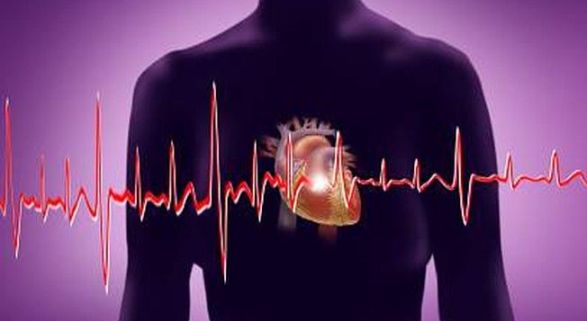Wide Effects of Heart Hormone are Found
The revolutionary discovery of a hormone made by the human heart is scarcely two years old, but it has already spawned a whole new field of research as scientists begin to understand the substance's natural role and investigate ways of using it to treat heart disease, high blood pressure and kidney failure.
Specialists who study heart and kidney function are fascinated by what they have already learned about the hormone. It helps dispose of excess sodium in the blood and thus seems to play a role in regulating the amount of salt in the body. It appears to act as a counterbalance to other vital hormones in governing blood volume and pressure. It is present in large amounts in the blood of patients who suffer from congestive heart failure and certain kinds of abnormally fast, irregular heartbeats. In animal experiments even small amounts of the hormone gave powerful aid to the functioning of failing kidneys.
The heart hormone is being studied all over the world, and many drug companies are hard at work trying to adapt it for use as a drug. Indeed major companies, working with doctors at hospitals here and abroad, are already testing the hormone in humans. It has been the subject of thousands of scientific reports and several conferences, including a large international meeting held earlier this year in New York under joint chairmanship of Dr. John H. Laragh of New York Hospital-Cornell Medical Center and Dr. Barry Brenner of Harvard Medical School.
One of the most fascinating new discoveries concerning the hormone has been the powerful effects that minute amounts can produce. "The doses are so low you can barely see shifts in the blood levels," said Dr. Philip Needleman of Washington University in St. Louis. "It is quite stunning."
Dr. Laragh said he had never seen "a single subject so intensively studied." One reason for the intense interest, he said, is that the concept of the heart as a hormone-producing organ is revolutionary.
"I think the astonishing thing about this hormone, that all studies are showing, is that within minutes of its secretion by the heart it reduces the blood volume," Dr. Laragh said. The effect of this reduction in circulating blood is to reduce sharply the workload on the heart.
Several related actions seem to bring about the reduction in volume, Dr. Laragh said. Fluid leaks selectively from the capillaries into the tissues.Blood vessels seem to relax and blood pressure falls. The kidneys begin to filter the blood at an accelerated rate and to release more salt into the urine. Salt acts to maintain proper blood volume, but in some people an excess can increase both volume and pressure.
Dr. Laragh said the hormone's actions appeared to be like those of several different classes of drugs used against high blood pressure, which help excrete salt from the body, blocks hormones such as renin and aldosterone that tend to keep blood pressure up and appears to relax blood vessels.
Because the field of study is so new, scientists differ over the hormone's precise effects, over what triggers its release and over the central issue of what its normal functions may be in the human body. They note that the hormone is just one newfound substance in a complex system of blood regulation involving many hormones and enzymes.
Some believe it is in play continuously to help maintain the proper balance of pressure and volume in the circulating blood. Others suspect it may come into major action more selectively in the face of disease or some emergency that distorts the fluid flow and pressure of the blood.
In either case, scientists say, it might be possible to mobilize the hormone's actions for medical needs or to produce related substances that could be used as drugs. Many drug companies here and abroad, scientists say, are active in research on the hormone, including Wyeth Laboratories; the Monsanto Company working with Searle Laboratories; Merck Sharp & Dohme; Smith Kline & French Laboratories, and one or more Japanese drug companies.
The wealth of new research by many scientists is aimed at applications and also at better understanding of the hormone's natural role.
While two years ago it was unclear whether there was one such heart hormone or several in humans, scientists now agree there is almost certainly one substance produced primarily in the atria, the heart's two upper chambers of the heart.
In an inactive form, the hormone is apparently stored in granules in the tissues of the atria. The existence of these granules has long been known, and 20 years ago, Dr. George Palade, Nobel-prize-winning scientist at Yale, noted that their appearance suggested they might contain a hormone. It took many years to find it. In its active form, the hormone, which circulates throughout the body, is a relatively small chain of 28 amino acids chopped from a much larger molecule by some still-undiscovered enzyme. The biological function of the rest of the molecule is unknown.
Chains of amino acids are called peptides. Consequently the hormone is known as an atrial peptide, but different scientific teams that have been pioneers in studying it have given the hormone a variety of different names. The research group at Cornell and New York Hospital have named it auriculin. Drs. Needleman and James E. Greenwald of Washington University, St. Louis, call it atriopeptin. Dr. Adolpho J. de Bold, who is credited with the original discovery, calls it cardionatrin.
Recent studies indicate that the hormone circulates continuously in the body in minute amounts and is released in larger quantity when excess salt is taken in or when circulating blood volume increases sharply. Although it was first found in the atria, new studies show that the heart's main pumping chambers, the ventricles, are also capable of making it and can be induced to do so in experiments.
The research credited today with opening the entire new field of heart hormone research was that of Dr. de Bold, then at Queen's University and Hospital in Kingston, Ontario. He is now at the heart institute of Ottawa University. In 1981, he showed that something in the ground-up atria from rats produced surprisingly sharp and prompt reduction in blood pressure when the material was injected into other rats.
While his research demonstrated that the hormone existed, its chemical identity was not discovered and analyzed until 1984, by several groups including Dr. de Bold's, Dr. Laragh's and that of Drs. Needleman and Greenwald. The huge flowering of research resulting from this work has come within the last two years.
"From studies in both laboratory animals and man, there is now no doubting that atrial peptides are secreted by the heart, circulate in blood and are rapidly removed from plasma by various tissues," said an editorial in The Lancet two months ago.
Special receptors with which the hormone interacts have been found in cells of the blood vessels, kidney and adrenal glands. Scientists speculate that the atrial hormone represents a system that acts in complement to other hormones to maintain proper blood pressure and volume.
The atrial hormone has also been found in the brain in aggregations of nerve cells that are known to be important in regulating blood pressure and blood volume.
Dogs and cows have heart hormones chemically identical to that in humans. The hormone in rats is very slightly different. A comparable hormone even exists in sharks. This suggests that the substance is so important that it has persisted through many million years of evolution.
Dr. Laragh said scientists at Cornell, led by Dr. Steven A. Atlas and Dr. Robert Cody, were the first in this country to test the substance in humans.
"We gave it first to ourselves," he said, "and now we are giving it to patients in heart failure and in high blood pressure." He and others estimated that, by now, hundreds of humans have received the hormone in medical studies throughout the world.
For use as a drug against high blood pressure, it has a major drawback. The hormone cannot be given by mouth but must be administered by injection or continuous infusion into a vein. In addition, its action, although powerful, is short-lived.
Dr. Needleman said animal experiments had shown that continuous infusions of tiny amounts of the substance reversed high blood pressure within a few days.
But excessive high blood pressure is a condition that must be treated for the patient's entire lifetime, and neither injection nor infusion of a short-acting drug would be satisfactory for that kind of treatment. For that reason, many drug companies are studying the effects of the hormone or are working on how the heart might be stimulated by a drug to make more of the hormone or how long-acting drugs that could be given by mouth might be designed to mimic its desirable actions.
"I think nearly every drug company everywhere is working on some aspect of this problem," Dr. Needleman said.
He questions the usefulness of the hormone as a drug for congestive heart failure. The new evidence shows that such patients already have high levels of the hormone, he said, and it is possible that the useful limit has been reached and that receptors with which the hormone must interact would be shut down by an excess.
In his view, kidney failure may be a particularly good medical target for the hormone. Experiments have shown that laboratory rats that have been treated so that they have only a fragment of their normal kidney function improve dramatically when given infusions of the hormone even in minute doses.
There are many thousands of Americans whose lives depend on regular treatments every week with dialysis machines to replace the blood cleansing actions their diseased kidneys can no longer manage. Conceivably, the health of many of them could be improved by infusions of the hormone accompanying each dialysis session.
"Clearly," said the recent editorial in The Lancet, "an important new hormonal system has been discovered, linking the heart with kidney, adrenal cortex, the microcirculation, and possibly the brain."
Whether it is involved in the "normal day-to-day regulation" of circulating blood volume and just what it does to help protect the heart and circulatory system against dangerous excess of blood volume, the editorial said, "are important questions still to be answered."







